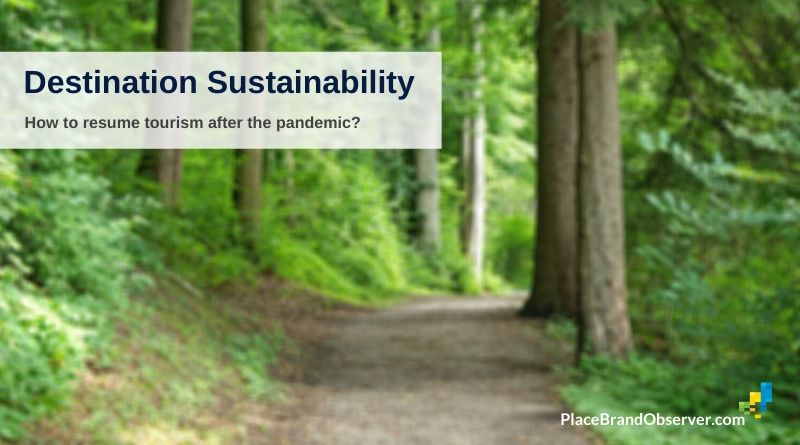As more and more countries manage to reduce the spread of the COVID-19 virus, there is a strong interest – and, indeed, industry pressure – to reopen borders and to revive the tourism economy. At this juncture, when feelings are running high to kickstart the economy and to reclaim jobs, the question arises: what can destination marketers and managers do to encourage a tourism experience which is more closely connected to destination sustainability – especially in terms of being good for residents and the natural environment?
That’s what we asked our panel of specialists, in collaboration with the Sustainability Leaders Project. Here’s what they answered (in alphabetical order – highlighted respondents are available for consulting, research, or as speakers).
 In partnership with the Sustainability Leaders Project: sharing and celebrating success stories of sustainable tourism leadership since 2012.
In partnership with the Sustainability Leaders Project: sharing and celebrating success stories of sustainable tourism leadership since 2012.
Our key takeaways:
- A triple bottom line approach with a focus on people, environment, and profit should drive all tourism recovery measures. The UN Sustainable Development Goals provide a good starting point.
- Define the sustainability agenda of your destination with respect to its unique features. Don’t blindly copy what others are doing.
- Implement new KPIs that focus on high-value tourism, rather than volume attracted through price-competition, to ensure that the mistakes of overtourism from pre-COVID days aren’t repeated.
- Your destination’s community (locals) and their interests should be central to any rethink of strategy.
- Encourage slow tourism and longer stays at your destination, for example by limiting offers of short-term rentals, low-cost carriers serving your destination, or cruise liners.
- Communicate well internally and make sure businesses and locals are on board, to set an example to tourists, to behave responsibly.
- Hygiene is on everyone’s mind, which means that as a destination manager you should make sure all involved pay utmost attention to cleanliness and physical distancing norms.
- In your marketing efforts, clearly communicate the safety measures you are undertaking, so that travellers feel safe when visiting.
- Start with the local market and domestic visitors, making sure your destination community is recovered and ready to welcome visitors.
This is just a snapshot of the very intriguing and insightful answers from specialists around the world, which you find in full length below.
Andrew Hoyne
Hoyne Design / Speaker profile
Different places have different sets of criteria for a framework that constitutes destination sustainability. It’s key to involve local businesses and residents because ultimately, it will impact them the most. Ensure the local market is the priority before engaging potential visitors.
In some cases, it will be about amplifying what a place has always been well known for, and is considered part of the place’s DNA. However, in other instances, this is an opportunity to reposition or pivot, and look to change the narrative which better suits local needs, creating meaningful differentiation (which in turn drives price premiumisation). In addition, differentiation is another factor of destination sustainability, because it is much more difficult for other places to replicate.
So, to answer the question:
- Engage locals as a priority audience (and with a mindset of them as business partners). Treat them as both customers and ambassadors.
- Create clarity around the unique place DNA.
- Develop new solutions to create further differentiation.
Caio Esteves
- I would first try to understand how the destination will behave. A popular destination yesterday may not be a popular destination after the pandemic.
- More importantly, I would share with the community a clear strategy for resumption, seeking common goals, and explaining the importance of tourism to the local economy. If we have seen recent cases of tourismophobia in the pre-COVID world, now with the threat of new pandemics, the gathering of people has an even more negative impact, and also, now on health.
- Finally, I would create a multidisciplinary committee to define the sustainability objectives of the destination and create metrics for those objectives that could impose taxation or limits when the parameters went out of expectations. But it is important to say that, apparently, the concern in the short and medium-term is the opposite: not to limit anything, but to stimulate and promote a resumption of tourism activity.
Günter Soydanbay
Soydanbay Consulting / Speaker profile
Based on Tripadvisor data, the one factor that overrides everything else is ‘cleanliness’. Before COVID-19, that was a point of parity – a primary value that the travellers expected to be in place for any destination that they considered. Going forward, it will be a point of differentiation for a while. So, establishing the perception of superior cleanliness would be at the top of my priorities.
My second order of business would be to build resilience through diversification. By that, I mean two things:
- Diversification of my target audience: Starting with the inhabitants of the city, then locals of the country, and finally, the type of foreigners that were not at the top of my list before.
- Diversification of my product: Research shows that people would want to stay away from busy, centrally-located popular spots, and seek off the beaten path and new places. That’s why this would be the perfect time to diversify the range of my offering.
Finally, going forward, funding will be an issue. That’s why I will have to prove that my strategy and tactics are generating positive ROI. To be able to do that, I would beef up my measurement capabilities. [More on how to measure place branding success here]
Heather Skinner
Involve local communities in the plans to restart tourism from scratch: real stakeholder engagement, where destination managers involve and listen to local communities, and then act on those insights when forming their plans.
Prioritising and promoting local sourcing of consumables (linking food and drink to the destination, encouraging the use and promotion of local consumables); and of staff. Having local people working in hospitality and tourism, training and developing them well is of much greater benefit to the local economy and offers more authenticity for the tourist experience than being served by foreign staff flown in for the tourism season.
Focus on a niche and alternative tourism. Move away from mass tourism models, because in many destinations more does not always mean better. A focus on the growth of tourist numbers as we observe in so many tourism strategic plans is not sustainable and does not make tourism more closely connected to the destination. Some destinations should think about targeting more specific niches, where fewer tourists could bring in the same – if not more – revenue to the destination.
Hjörtur Smárason
Scope Communications / Speaker profile
Slow tourism, slow tourism, and slow tourism. This is the winning strategy of tourism in the 2020s.
By immersing yourself in a single destination:
- you minimise the risk of contagion
- you get a deeper experience of the place you are visiting
- you are more likely to learn and develop yourself
- you leave more for the local community, and
- you minimise your carbon footprint.
This is, therefore, more attractive for both the consumer and the provider in tourism, both in terms of the consequences of the pandemic as well as the pressure of climate change.
Jeannette Hanna
Trajectory Brand Consultants / Speaker profile
- Focus on rebuilding local confidence. The people most invested in the long-term sustainability of a place – economic, social, and environmental – are locals. Visible and creative collaborations involving residents, businesses, and community groups reinforce the community’s capacity to adapt and be resilient. Harness community pride, willingness to contribute, and we’re-all-in-this-together spirit with fun, new traditions (e.g. take-out nights to support local restaurants) and socially-distanced cultural happenings (e.g. drive-by exhibits). Help locals rediscover their place with local ‘insider’ tips.
- Inspire creative collaborations. Inspire people to reimagine old conventions and think outside the box with new kinds of collaborations and experimentation with culinary, retail, arts, and cultural offerings. Take advantage of the fact that people are primed to explore new approaches. Positive new experiences are also valuable to help counter the sense of loss that many feel.
- Stay connected. It’s important to understand the psychological climate. Invite input from the community – what does success in this phase look like for you? When people are feeling insecure, they often jump to conclusions that are unfounded. Know the facts and use them to counter knee-jerk reactions. Provide goals and context for decisions – here’s where we are and here’s where we’re hoping to go next.
Joao Freire
- Limit the offer of short-term rentals.
- Look for a more balanced offer between office spaces and places catering to tourists.
- In the case of cities, involve universities in the place branding strategy to attract more international students, researchers, and entrepreneurs.
Juan Carlos Belloso
I would review, together with the key destination stakeholders, how resilient and tourism-dependent the destination is. Think about strategies to prepare the destination for a more sustainable and resilient, medium, and long-term development, in terms of economic sectors, social and human development, and environmental sustainability.
Then I would review, again with the key stakeholders, the current (prior to COVID) tourism model for the destination, evaluate the short and mid-term impact of the situation, and:
- define short term measures to bring back tourism activity to the destination (health / sanitary measures, reinforce domestic tourism, etc.)
- define and implement a more sustainable and resilient tourism (and overall sustainable development) model for the future.
I would support strategies, initiatives, and stakeholders that would have sustainability and inclusion as a priority.
Malcolm Allan
I’d take the following actions:
- Seek agreement with and between destination tourism businesses and organisations on exactly what safe destination sustainability means, in the reality of how their business is undertaken and their offer delivered, in safe ways.
- Seek agreement on rating safe and sustainable tourism business conduct as a contribution to effective destination sustainability, a ‘kitemark’. For e.g., the Visit Britain Kitemark for tourism businesses complying with safety measures and publicise those local tourism businesses complying with it.
- Create an awards scheme to recognise tourism businesses’ contribution to safe destination management and sustainability.
- See this as an opportunity to rethink the tourism sector and redefine how it should operate in a very sustainable way, more so now, than it has until the advent of the pandemic – to demonstrate that it is being taken seriously, reconfiguring or reimagining its brand offer to describe its changed and future place and the nature of its changed tourism offer.
Martin Boisen
For the love of place / Researcher profile
I think it is very important to have a clear idea about the ‘why’ here. What do you want from the visitor economy? Try to answer this question as detailed as possible, in search of real answers – not just the outworn (and often untested) assumptions. The first step is to figure out what a community really needs and wants (and what it does not want) from the visitor economy. When you know that, you can develop strategies on how to achieve those objectives in a way that minimises the impact on the social, economic, and environmental sustainability. I know it’s old school, but I am still a fan of the triple bottom line approach (people, planet, and profit).
There’s the part about ‘encouragement’. Though I acknowledge the rising awareness amongst certain niche markets of tourism, I am not a fan of believing that encouragement and education/information is going to solve too much here. We shouldn’t leave it up to the tourism businesses or the tourists themselves. We should also look for enforcement. Not a popular word in these individualistic times, but rules and regulations are necessary to help balance out the earlier mentioned triple bottom line.
With the above noted, I believe that there’s a lot of progress to be made in making the social, environmental, and economic impact of tourism choices more transparent to visitors. For example, there’s an opportunity in labelling accommodations and attractions based on their ecological footprint (the smaller, the better) and their local economic footprint (the larger, the better). If the system behind such labelling is secure enough, the application of the system might be required by law. In some places, the level of tourism tax could even be differentiated based on the label category.
Natasha Grand
The principal way for ‘teaching’ tourists to be responsible is for the place to become sustainable by itself. In other words, if sustainability is part of the locals’ own mentality, and is a norm of life for them, then the visitors will behave on the same lines. Hence:
- Establish if sustainability is really a pertinent value for the locals and if this sits well with their own identity and lifestyle – it may not be.
- Offer and promote ways to habituate sustainable living within the place.
- Communicate the importance of sustainability in your promotional materials and content, so that the visitors are aware and choose accordingly.
Robert Govers
Independent advisor / Speaker / Researcher
Assuming politicians would let me and I’d have the resources to do so, I would:
- Restrict access for large-volume operators (cruise liners, tour operators, low-cost carriers, etc.) and subsidise fine-grained targeting.
- Charge hefty destination access fees (not €20 or €30, but €120 or €130 a day), but make museums, monuments and other public attractions free of charge, yet access-restricted by pre-booking on an individual basis (per household).
- Provide temporary business support through interest-free loans, extended repayment periods, and partial unemployment compensation for workers in order to compensate potential temporary negative effects of the transformation and the need for businesses to reorient (we were able to do it during the COVID-crisis, why not during the recovery?).
We need to move away from price-competition and low-hanging fruits. We should make sure to attract those travellers who are willing to invest time, money, and effort to come and visit that unique destination (which it must be if it’s as popular as the question suggests). Consumers are willing to pay €80 to attend a soccer match or €300 for a rock festival. Unique destinations that are worth a once-in-a-lifetime visit should be equally valuable; not a public commodity!
Sebastian Zenker
Ban (or drastically re-think) cruise tourism: To a large extent the economic benefits from cruise tourists do not reflect the harm and crowdedness these customers bring. Many cities have invested in their cruise infrastructure and keep on pushing the agenda (sunk-cost effect) knowing fully well that the ecological and social costs are negative for the city.
Rethink low-cost carrier flights: The mid-term (and maybe even long-term) goal is not ‘more and more’ tourism anymore, but ‘better’ tourism. Berlin, for instance, calls it high-quality tourism. This unfortunately means also targeting different kinds of tourists – people spending more and blending in more. A cheap connection to this place may not be the best idea anymore (but rather some exclusivity).
Link public financial support to sustainability: It is very clear that the tourism industry is one of the hardest-hit industries by the pandemic. It is also unquestionable that the industry needs financial governmental support. These transfers should although not come free. “Never waste a good crisis” as Winston Churchill said. Companies getting public money should be forced to come up / invest in their sustainable development.
Todd Babiak
I would use this pause to ensure I understand local culture and ambition. Who are we, what do we want, and where are we going together? Before we understand that, it’s difficult to tie any tactical plan to ‘sustainability’. Random, panicked decisions are the enemies of good strategy.
So first, my team and I would do one hundred, hour-long interviews with a mixture of tourism operators and regular citizens, a random sample, asking them a series of tough questions. If one hundred isn’t enough to come up with a consistent and powerful response, I would do more. Who are we, at our best? What do we leave behind? What do we turn up?
Then I would distill the results of those interviews into a cultural expression: a story, in plain language, about where we’ve been, where we are, and where we’re going.
Then I would work with partners to put together a five-year plan, based on what we’ve learned, to unify our efforts. There’s probably a campaign there, but we don’t launch it until we know what we want and what segments of the tourism market might want to join us.
Tom Buncle
Yellow Railroad Consulting / Speaker profile
Focus on community, community, community!
For too long, destinations particularly at the national level have played a numbers game and chased visitors without considering the impact on the host community, their culture, and the environment. Therein, lay the seeds of ‘overtourism’.
Start with three practical steps:
- set up a community engagement forum
- develop a destination management plan
- establish a visitor impact monitor to assess the effect of visitors on the local community, environment, and cultural heritage, so that well-informed decisions about investment, development, and marketing can be made. This will ensure the local visitor economy develops in a way that is acceptable to the local people.
Andrea Lucarelli
I think this might be a good time to rethink what a destination is. Get rid of all the older ultra-neoliberal models of destination planning, management, and revenue system of thinking. This is a moment where the power of imagination of a ‘different’ destination, with different qualities and with more local participation and footprint is possible.
Rediscovering the sense of community is the first thing I would do, for example by helping to re-establish only those businesses that have a real ‘stake’ in the destination.
The second thing would be to plan for future crises. Humans have a short memory and thus building up a historical overview is important.
Third, instead of promoting, communicating, or using ‘sustainability’ as the main offering, practice sustainability without ‘showing off’.
Bill Geist
We need to be talking, not just to our hospitality partners but, to our residents. Are they ready to welcome visitors to our community? Just as cities that pushed back on the ways that tourism degraded their lives pre-COVID, we need to better understand their fears and needs.
The messaging must be about safety. Assuring prospective visitors that your destination is addressing state-of-the-art virus protocols will be the new black.
We need to reassess our old business models. What can we leave behind that wasn’t producing a high-ROI but that we continued to do because we always had?
Buck Song Koh
Integrate local community participation – A tourism destination can be holistically sustainable only if the residents who live in that location are actively involved in tourism’s spinoff economic activities, and themselves derive economic – and also psychic – benefits of such participation.
Prioritise high-value tourism – Tourism brings the highest levels of reward for all stakeholders when the focus is not on increasing the sheer numbers of tourists, but more importantly, their value-add and quality, which includes aspects such as respect for nature and culture.
Infuse branding content with sustainability emphasis – All the content that is created for brand-building (in mainstream and social media) must be consistent with, and indirectly help communicate, the key ideas of sustainability attached to the destination, so as to guide all follow-on actions.
Cecilia Cassinger
Based on my research on urban destinations, I would:
- Develop a tourism strategy in dialogue with the resident community to make tourism sustainable and resilient to the crisis over time. This can be achieved by providing meaningful and high-quality tourism experiences that make fewer people stay longer. Find alternative ways to attract a heterogenous group of tourists with different interests.
- Integrate destination management with city planning and development strategy to make tourism a prioritised political question; stop treating it as an isolated issue. Urban tourism is part of everyday life in the city.
- Limit low-cost carriers that enable people to visit the destination for a short time and encourage longer stays. Encourage tourists to travel on the ground with trains.
Eduardo Oliveira
We live at a time when Earth’s ecosystems are more vulnerable and depleted than they have ever been. Now, more than ever, destination managers need to focus on implementing Nature-Based Solutions (NBS), if they truly want to achieve sustainability targets. NBS are powerful tools to capture carbon from the atmosphere.
From a climate change perspective, destination managers and place branding experts must think about how to attract people and businesses while supporting regenerative measures, to achieve the three pillars of sustainability: social, economic, and ecological.
Only when local communities benefit from the social, economic, and ecological benefits that the tourism activity provides, can popular tourism destinations be sustainable.
Hila Oren
Seeking to re-start tourism under new circumstances enforced by the coronavirus, such as social remoteness, I would:
- Encourage accommodation in people’s homes – ones that have their own yards, for instance.
- Operate nocturnal tourism – ‘stretching’ the hours to the night, when there is less ‘day-time’ activity in the cities.
- Promote ‘geographical’ tourism in the open-air – every place has nice spots which are not always obvious, and it is an opportunity to explore them.
- Develop ‘community’ tourism – by areas of interests such as the tourists’ profession (artists, architects), hobbies (jewelry making, food), or gender preferences. This kind of tourism allows for social remoteness but still takes a more personal approach while enabling web usage.
Inga Hlin Palsdottir
Sustainable development goals – Sustainability of destinations has a focus on economy, environment, and society – with the Sustainable Development Goals at heart. Therefore, depending on the destination, I recommend cracking what are the most important things for your destination and what you are able to do right now in order to get tourism closer to destination sustainability. It depends on what kind of destination you are representing (e.g. city, municipality, region, or a country) and what kind of products (e.g. nature, culture, activities) as all places will have different sustainability strategies based on their priorities.
Stakeholders engagement – Get all stakeholders involved in planning and reassessing strategy to restart the future with the Sustainable Development Goals as a front. Clear measurable objectives are vital, so everyone has the same vision and objectives for future development with a focus on sustainability. All stakeholders including government, municipalities, citizens, tourism industry/companies, investors, and your foreign stakeholders e.g. tour operators, etc.
Target audience – Be clear about your target audience and what kind of travellers the destination is seeking, in line with the sustainability strategy of the destination. Depending on what kind of destination we are looking at and what the emphasis is on e.g. culture, nature, activities, etc.
Irina Shafranskaya
In my opinion, this is a very good moment to start a dialogue between tourism managers and local communities. Instead of the process approach, it’s time for projects in the tourism sector. As we are not able to plan long run programmes, short projects, aimed to help the local business to recover, are the central solution for the current time.
Keeping this in mind, three requirements for such projects could be considered:
- Crowdsourcing the ideas locally and involving the locals as the ‘last service mile’ of tourism product delivery.
- Connecting the aims of the projects with the ideas of sustainable development – not only declaring them but trying to implement as much as possible.
- Involving youngsters into these projects.
Jaume Marín
If I had to choose three things, it would probably be:
- The load capacity of the different venues, heritage sites – and try to work heavily on seasonality.
- Strengthen the products related to identity, as those make us different as a destination.
- Try to involve locals in tourism planning, and as well as tourism developers.
José Pablo Arango
- I would design new rules of behavior according to destinations.
- I would impress those new rules on visitors.
- I would communicate it.
Marta Hereźniak
- Reconnecting with the local community and local stakeholders to be able to include them in the development and implementation of brand-related activities and to minimise the adverse effects of tourism on the locals. Developing a relational network of local producers and service providers and making them a legitimate part of the industry.
- Developing public policies and certification systems that encourage and support sustainable solutions in the industry.
- Developing a communication and pricing strategy to:
(a) target the travellers for whom sustainability is an important choice criterion
(b) to promote and stimulate sustainable behaviour within the existing customer base.
Sonya Hanna
If there was ever an upside to the current global public health crisis i.e., COVID-19, it is that it is making a positive impact on our natural environment. Marketers are facing a challenging paradox between revitalising their economies and building on their ‘cleaner’ destination image.
To restart a sustainable ecosystem, destination marketers/DMOs are reminded:
- To foster grassroots cross-community cooperation, to acknowledge and recognise the interdependencies between the public and private sector to really (re)commence the co-creation of the kind of society we want to live in.
- That all (or the majority of) stakeholder interest should be identified and understood, but this does not necessitate that all stakeholders should be equally involved in the decision making.
- That initiative (be it national, regional or local) can only go so far, and that structural change embedded in policy is required. This necessitates re-imagining the way that destinations are (re)built and organised.
Previous panel answers to hot topics and urgent questions here.
You’d like to ask the panel a question? Let us know!
Did you enjoy this summary of expert views on how destination marketers and managers should work to resume tourism after the pandemic, while ensuring sustainability? Thanks for sharing!

















